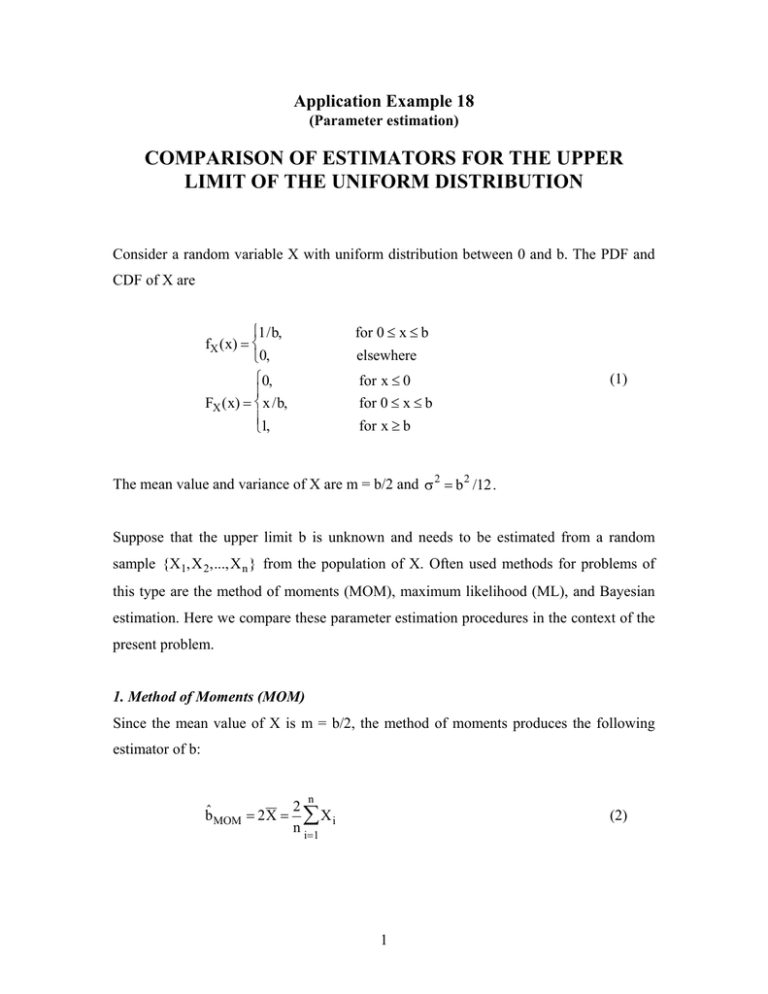COMPARISON OF ESTIMATORS FOR THE UPPER LIMIT OF THE UNIFORM DISTRIBUTION
advertisement

Application Example 18
(Parameter estimation)
COMPARISON OF ESTIMATORS FOR THE UPPER
LIMIT OF THE UNIFORM DISTRIBUTION
Consider a random variable X with uniform distribution between 0 and b. The PDF and
CDF of X are
⎧1/b,
fX (x) = ⎨
⎩0,
⎧0,
⎪
FX (x) = ⎨ x /b,
⎪1,
⎩
for 0 ≤ x ≤ b
elsewhere
for x ≤ 0
for 0 ≤ x ≤ b
for x ≥ b
(1)
The mean value and variance of X are m = b/2 and σ 2 = b 2 /12.
Suppose that the upper limit b is unknown and needs to be estimated from a random
sample {X 1,X 2 ,...,X n } from the population of X. Often used methods for problems of
this type are the method of moments (MOM), maximum likelihood (ML), and Bayesian
estimation. Here we compare these parameter estimation procedures in the context of the
present problem.
1. Method of Moments (MOM)
Since the mean value of X is m = b/2, the method of moments produces the following
estimator of b:
n
2
bˆ MOM = 2X = ∑ X i
n i=1
(2)
1
This estimator is unbiased, since E[bˆ MOM ] = 2m = b , and has variance Var[bˆ MOM ]
⎛ 2 ⎞2 2 b2
= ⎜ ⎟ nσ = , where we have used σ 2 = b 2 /12.
⎝ n⎠
3n
A problem with the method of moments is that bˆ MOM may be smaller than the largest
value in the sample, X max = max{X1,X 2 ,...,X n } . In this case it makes no sense to use
bˆ MOM .
2. Maximum Likelihood (ML)
The previous problem can be avoided by using the method of maximum likelihood (ML).
The likelihood function has the form
n
A(b | X1, X 2 ,..., Xn ) ∝ ∏f X ( Xi | b) ∝
i=1
1
, for
bn
0, for
b ≥ Xmax
(3)
b < Xmax
The function in Eq. 3 is maximum for bˆ ML = X max . Since X max is the maximum of n iid
variables with the distribution in Eq. 1, the distribution of this estimator has the following
CDF and PDF:
⎧0,
⎪
Fbˆ (x) = ⎨(x /b) n ,
ML
⎪1,
⎩
⎧ n n−1
⎪ x ,
fbˆ (x) = ⎨ b n
ML
⎪⎩0,
for x ≤ 0
for 0 ≤ x ≤ b
for x ≥ b
for 0 ≤ x ≤ b
elsewhere
2
(4)
The mean value and variance of bˆ ML are
E[bˆ ML ] =
∞
∫ xfbˆ
0
ML
(x)dx =
b
n
n
∫ bn xndx = n + 1 b
0
Var[bˆ ML ] = E[bˆ 2ML ] − (E[bˆ ML ]) 2 =
b
∫
0
⎛ n ⎞2
n n +1
x dx − ⎜
b⎟
⎝n +1 ⎠
bn
(5)
⎡ n
n2 ⎤ 2
n
=⎢
−
b2
⎥b =
2
2
(n + 2)(n + 1)
⎣n + 2 (n + 1) ⎦
1
n
for bˆ MOM and
for bˆ ML , is
2
3n
(n + 2)(n + 1)
A comparison of the variance prefactors,
shown in Figure 1. As one can see, the variance of bˆ ML is smaller than that of bˆ MOM ,
especially for large n. In this regard, notice that the variance of bˆ MOM depends on n like
1/n, whereas (for large n) the variance of bˆ ML has an unusual 1 /n 2 behavior.
n
1
10
100
1000
10000
1
Variance Prefactor
0.1
Modified ML
0.01
MOM
0.001
ML
0.0001
Figure 1. Comparison of the variance prefactors of bˆ MOM , bˆ ML , and bˆ ' ML
3
While the above feature makes bˆ ML a more attractive estimator than bˆ MOM , a drawback
of bˆ ML is that it is biased. To eliminate the bias, one may use the modified ML estimator
n +1 ˆ
n +1
bˆ ' ML =
b ML =
X max
n
n
(6)
whose mean value and variance are
E[bˆ 'ML ] = b
Var[bˆ ' ML ] =
Also the variance prefactor
n
(n + 1) 2
1
b2 =
b2
2
2
n(n
+
2)
(n + 2)(n + 1)
n
(7)
1
in Eq. 7 is shown in Figure 1. As one can see, this
n(n + 2)
prefactor is intermediate between those of bˆ MOM and bˆ ML .
Estimators that are not necessarily unbiased (here bˆ MOM and bˆ ' ML are unbiased, but
bˆ ML is biased) are often ranked based on the mean square error (MSE), which is the
second initial moment of the error e = bˆ − b. Hence MSE = E[e 2 ] = σ 2bˆ + (E[bˆ − b]) 2 . For
the above estimators, MSE is given by:
1
MSE[bˆ MOM ] = Var[bˆ MOM ] = b 2
3n
MSE[bˆ ' ML ] = Var[bˆ ' ML ] =
1
b2
n(n + 2)
(
(8)
)
MSE[bˆ ML ] = Var[bˆ ML ] + E[bˆ ML ] − b
2
⎡
n
1 ⎤ 2
2
b =
=⎢
+
b2
2
2⎥
(n + 1)(n + 2)
(n + 1) ⎦
⎣(n + 2)(n + 1)
4
The prefactors of b 2 in these MSE expressions are compared in Figure 2. Notice that,
except for n = 1, the modified ML estimator bˆ ' ML has the best performance.
n
1
10
100
1000
10000
1
Variance Prefactor
0.1
0.01
MOM
ML
0.001
Modified ML
0.0001
Figure 2. Comparison of the variance prefactors of bˆ MOM , bˆ ML , and bˆ ' ML in the MSE
expressions
3. Bayesian Estimation
Bayesian analysis requires specification of a prior distribution for b, say in the form of a
prior density f'(b) , combination of the prior density with the likelihood function in Eq. 3
to obtain the posterior density f"(b) ∝ f'(b) ⋅ l(b) , and finally the choice of an estimator of
b. The estimator may be based on f"(b) (for example one might use the a-posteriori mode
or the a-posteriori mean) or calculated by minimizing an expected loss function.
Consider for example a prior density of the gamma type,
f'(b) ∝ bα−1e− b / β ,
b≥0
5
(9)
where α, β > 0 are parameters. Then the posterior density of b is
f"(b) ∝ b (α− n )−1e− b / β ,
for b ≥ X max
(10)
Ignoring for the moment the constraint b ≥ X max , the function in Eq. 10 is maximum for
b = max{0, β(α − n −1)}. We conclude that, if one estimates b as the value that maximizes
f"(b) , the Bayesian estimator bˆ Bayes is given by
bˆ Bayes = max{X max , β(α − n −1)}
(11)
It is interesting that bˆ Bayes is the same as bˆ ML when β(α − n −1) ≤ X max , which happens
for any given α and β if n is sufficiently large.
Problem 18.1
Implement the previous estimators for the following samples:
Sample 1: {5.2, 0.8, 2.7, 3.1, 6.4, 3.8, 1.7, 6.3}
Sample 2: {5.2, 0.8, 2.7, 3.1, 6.4, 3.8, 1.7, 16.3}
For the Bayesian estimator, use α = 20 and β = 1 in the prior. Comment on the results.
Do you find anything suspicious in the second sample?
6







